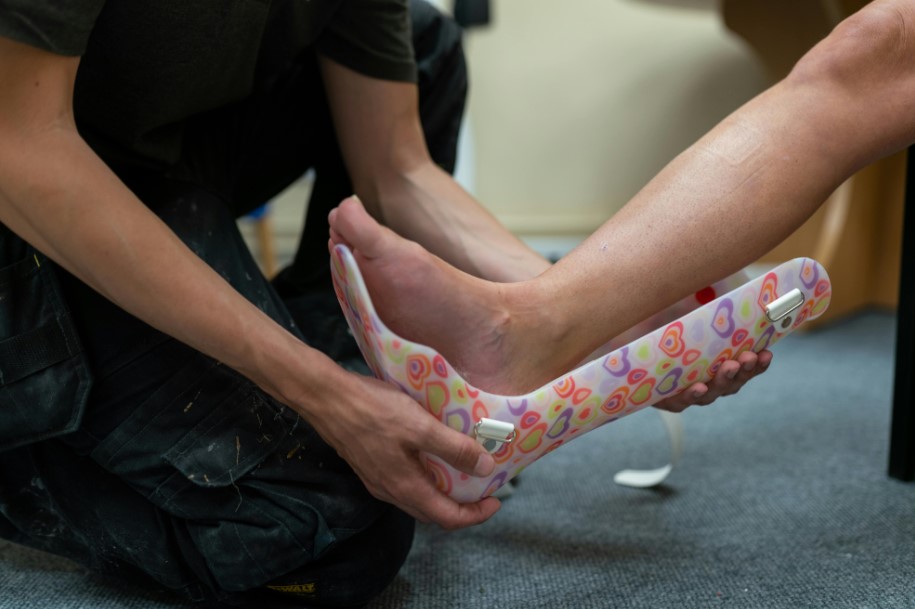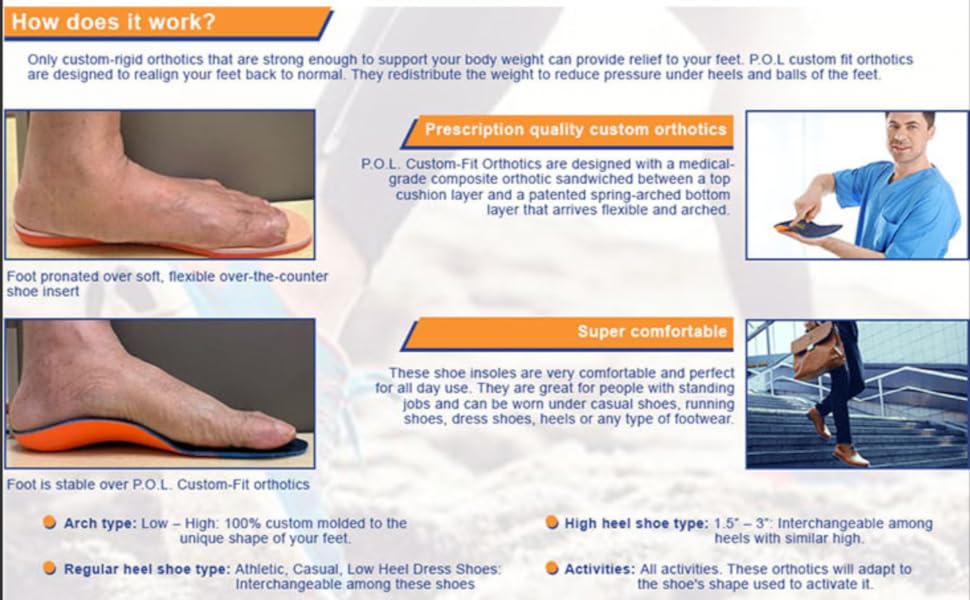
Custom orthotics stand apart from generic shoe inserts or over-the-counter insoles due to their personalised prescription and tailored craftsmanship catering to individual foot anatomy. By enhancing balance and alignment, they alleviate pressure on crucial joints like the hips, knees, and spine.
For those grappling with foot and ankle discomfort, custom orthotics present a transformative solution, facilitating enhanced mobility and enabling a more dynamic lifestyle.
They’re Custom-Made for Your Feet
Unlike shoe inserts, which are available in stores without a prescription and are often made of foam or plastic, orthotics are custom-molded to fit your feet. They’re designed to correct imbalances and provide support for the foot, ankle, knee, and lower back by distributing your weight evenly across the surface of your feet.
The process to create a pair of custom orthotics begins with a hands-on evaluation of your feet and your shoes. A podiatrist at your local podiatry clinic will examine your medical history and take a detailed look at the structure of your feet and how they relate to the rest of your body. You’ll also have a biomechanical examination that will include walking and standing tests.
To make a mold of your foot, your provider will use a casting method like plaster or a “stomp box” which has a piece of impression foam in it that you step into with each foot. It’s important that the provider is experienced in this so they can accurately position your feet as you walk into the box to avoid creating an orthotic that doesn’t address your unique biomechanics.
Depending on the type of orthotics you choose, they may be rigid enough to address structural issues such as arthritic pain or rigid joints. But they can also be softer to redistribute pressure and reduce friction. They can even be flexible to adapt to the motions of your feet during different activities.
They’re Affordable
Custom-made orthotics aren’t as expensive as they may seem. Especially when you factor in the potential for lower body pain relief, they can actually be cost-effective.
A qualified podiatrist, sports medicine doctor, or orthopedic surgeon will evaluate your feet and determine whether you need custom orthotics in Thornbury. Then they will perform a hands-on evaluation of your feet, ankles, knees, and hips to identify and address any underlying biomechanical issues that could be contributing to your foot pain.
The misalignments in the bones, tendons, ligaments, and muscles of your feet can actually have an impact on the kinetic chain on the rest of your body, including your back and knees. This is because the body compensates for imbalances by putting extra strain on other joints and muscles in an attempt to balance out the imbalance.
Often, the best way to get relief from lingering foot or lower body pain is with a pair of orthotics. You can purchase a pair of custom orthotics from a qualified healthcare provider for around $200 or you can purchase semi-custom over-the-counter insoles.
They’re Versatile
There’s a lot to love about custom orthotics, but the truth is, they’re not a universal solution for every foot and ankle issue. After all, most of us have ten total toes and two feet and ankles with over a hundred different muscles, tendons, and ligaments connecting to each other. If your feet aren’t healthy, the way that you walk and run will reflect this. If you’re prone to flat feet, or you have bunions or foot ulcers, you’ll need a more targeted treatment that focuses on your unique needs.
That’s why a hands-on evaluation is crucial when you’re looking into custom orthotics. You can find providers who will send you a stomp box where you step into it with each foot, and then the provider will make impressions of your feet. However, this kind of process isn’t always as effective as a face-to-face evaluation from an experienced provider.
A great way to think about your feet is as a long kinetic chain of motion. If your feet aren’t functioning optimally, they can throw off the whole system and lead to pain, discomfort, or even injury as other joints and parts of your body try to compensate. Custom orthotics can help stabilize your feet and align them in a more functional position that promotes healing, relieves pain, and takes stress and pressure off of other areas of your body.

They’re Effective
Foot pain, instability, and discomfort can cause a domino effect throughout your body. Your feet are like a link in an extensive kinetic chain, and any imbalances in their structure or function will impact your ankles, knees, hips, and back. When you invest in orthotics, they can improve your quality of life by promoting healthy motion throughout the body and helping you to maintain an active lifestyle.
The first step is a complete evaluation of your feet and their needs. This involves a physical examination, gait analysis and sometimes imaging tests. The evaluation will help your local foot doctors identify the specific issues and requirements of your feet, allowing them to tailor the right orthotics for your specific needs.
Using this information, your healthcare professional will capture a mold of your feet. This may involve either plaster casting, foam box impressions, or a digital scan. The resulting orthotics are built to fit your feet exactly, ensuring that they’re comfortable and effective.
Custom orthotics can treat a variety of foot and ankle problems, including overpronation, metatarsalgia, heel spurs, shin splints, arthritic knees, sprained ankles and rolled ankles. By enhancing stability, providing cushioning, and reducing pressure on certain areas of the foot, they can also prevent injuries such as stress fractures and shin splints. In addition, they can increase the effectiveness of shoe inserts, reducing the need for more expensive and time-consuming procedures such as surgery.




